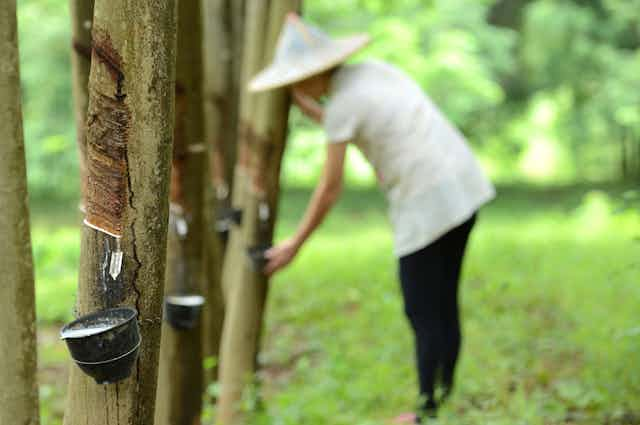Over 4 million hectares of tree cover – an area equivalent to the size of Switzerland – may have been cleared to make space for rubber plantations since the 1990s. Out of all the rubber planted, 1 million hectares may have been established in key biodiversity areas – sites that contribute significantly to biodiversity in terrestrial, freshwater and marine ecosystems.
These are the findings of our recent research, which mapped the conversion of land to rubber tree plantations across south-east Asia. The likely pace of forest loss that we found surpasses previous estimates.
The global demand for natural rubber, which is found in thousands of products including vehicle and aeroplane tyres, is increasing. In separate research, published in July 2023, we estimated that between 2.7 million and 5.3 million additional hectares of plantation area could be needed by 2030 to fulfil this additional demand. This is a concern. Research has found that rubber plantations support nowhere near as much biodiversity, nor do they contain as much carbon, as natural forests.
Most natural rubber is made by extracting latex – the liquid sap – from the Hevea brasiliensis tree in a process called “tapping”. As a tropical species, the places suitable for Hevea brasiliensis cultivation coincide with some of the world’s most biodiverse regions. Thailand and Indonesia, for example, are the world’s leading rubber producers.

Rubber’s impact on forests
We reviewed more than 100 case studies to understand what types of land are being converted to rubber. In many cases, rubber replaced natural forests. But we also noted instances of other plantation types and agricultural systems transitioning to rubber.
We then examined national statistics regarding the extent of rubber plantations and their productivity per hectare. Our findings revealed a global trend of expanding rubber areas in producer countries, coupled with static or declining yields.
Low yields are partly due to tapping less frequently in countries where prices are relatively low – though they are also probably caused by suboptimal tapping practices. As existing rubber stockpiles are eventually exhausted, prices should theoretically increase again, potentially leading to more frequent tapping of plantations that are currently not or only infrequently tapped. However, past trends suggest that more land will be established for rubber cultivation to meet the growing demand, rather than using existing plantation land more effectively.
Ivory Coast in west Africa emerged as a new hotspot for expanding rubber plantations. These plantations seem to be displacing cocoa agroforests (where trees or shrubs are grown around or among other crops or natural vegetation) in the region.
Using cutting-edge analysis of satellite data, which was based on the unique timing of rubber tree leaf drop compared to other tree cover, we more recently generated high-resolution maps of rubber distribution and the associated deforestation.
Our mapping revealed Cambodia as a country of particular concern, with 40% of rubber plantations associated with deforestation. These plantations were often located within protected areas.

Supporting livelihoods and economies
Most rubber that is produced in Asia is grown by smallholder farmers – people who farm less than five hectares of land. Rubber production thus forms the basis of many regional economies and supports the livelihoods of millions. Producing rubber sustainably in existing plantations, and avoiding further plantation expansion, is a critical part of protecting forests and supporting people.
In June 2023, the EU adopted a new regulation to curb the EU market’s impact on global deforestation. Alongside several other commodities, rubber is covered by this legislation. Any company looking to sell products containing these commodities on the EU market can only do so if suppliers can show that they were not sourced from land deforested after December 2020.
On the one hand, there is a risk that the new law may inadvertently marginalise rubber smallholders. Rubber is typically collected by middlemen and can change hands several times before reaching a processing facility. Smallholders will also largely be unaware of the new regulations and often may not have documentation showing their official land tenure.
Given the complexity of tracing smallholder rubber, larger tyre manufacturers and other rubber consumers may choose to source their rubber from industrial plantations that have the resources to prove that their rubber is compliant with the EU’s new regulation.

Opportunities for farmers
But, accompanied by the need to trace rubber supply, the new regulation could also offer opportunities to help smallholders improve their rubber production methods. Our research from July 2023 found that reducing land availability for rubber expansion could indirectly drive increases in production efficiency on existing land.
There is evidence that this is taking place in Mato Grosso – the largest soy and cattle-producing state in Brazil. Double cropping (where several crops are planted in the same area and in the same crop year) rates were significantly higher in regions where forest conservation policies were more stringent.
Natural rubber should not be demonised. Rubber plantations have the potential to sequester carbon and continue contributing to the long-term wellbeing of smallholder farmers.
There is also evidence suggesting that rubber agroforests can support at least some biodiversity. In a study published in 2019, we found a higher abundance of butterflies in rubber agroforests compared to monocultures. The presence of birds also increased in tandem with the height of herbaceous vegetation within rubber plots.
But this does not mean that the growing demand for natural rubber should be accepted as inevitable. A clear approach to reducing the adverse effects of rubber on forests and biodiversity is to curb our use of cars, especially in more developed regions where efficient public transport systems are, or can be, established. This would not only address carbon emissions from fossil fuels but would also reduce demand for rubber.

Don’t have time to read about climate change as much as you’d like?
Get a weekly roundup in your inbox instead. Every Wednesday, The Conversation’s environment editor writes Imagine, a short email that goes a little deeper into just one climate issue. Join the 20,000+ readers who’ve subscribed so far.


